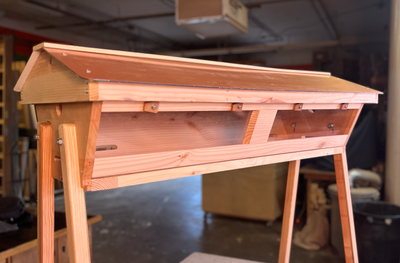Natural Beekeeping
natural beekeeping
Natural beekeeping is a phrase used to describe many different approaches to beekeeping. While there's no universal definition, our interpretation of natural beekeeping is minimal manipulation, natural combs, and no treatments.
foundationless beekeeping
Our goal is to provide the bees with a good environment in which they can thrive mostly on their own. In our opinion, the best environment is a hive with natural comb such as a top bar hive, Warré hive, or a foundationless Langstroth hive.
We go foundationless for 3 main reasons:
1
To keep plastic and contaminated-wax-coated foundation out of the hive
2
To let the bees build comb with natural cell size (smaller than traditional foundation), which drastically improves their ability to fight the Varroa mite
3
For simple honey harvest, done by crushing and straining. This encourages fresh comb production, and cycles old wax filled with pesticides and other detrimental compounds out of the hive.
Comb management requires monitoring while the bees are building out new comb. Simply keep an eye on the comb construction to make sure they are building straight from top bars or frames, and correct any comb that is starting to go off the tracks by molding it in place with a gloved hand, or securing it in place with a zip-tie over the top of the frame or top bar.
TREATMENT-FREE BEEKEEPING
CHEMICAL TREATMENTS AND NATURAL SELECTION
Honeybees were never fully domesticated, and many wild honeybee colonies are thriving without human intervention. In fact, honeybees lived without our help for thousands of years, and in this manner, adapted to environmental change and challenges over time. The most important variable in determining adaptability and hive success is good genetics. We believe the best method for overcoming Colony Collapse Disorder and the other struggles honeybees are facing is natural selection.
Right now, honeybee survival is directly influenced by their ability to withstand 4 main environmental factors: pesticides, Varroa mites and other parasites, disease, and extreme weather. Current practices in the beekeeping industry rely heavily on the use of chemical treatments to fight diseases and parasites. This pressures the diseases and parasites to become stronger, which then requires the use of even stronger treatments. The consequence is that we are breeding super-pests and diseases, and weak bees that rely on chemical treatments rather than developing their own methods for survival.
It is a common misconception that natural selection takes thousands of years to affect change. How fast an organism adapts, however, is directly influenced by how strong the selective pressures in their environment are. Current selective pressures on honeybees in North America are very strong. By not treating our hives with blanket antibiotics and miticides, we are allowing weak bees to die, and only the strongest bees to survive. We then propagate the genetics of the strong colonies by splitting surviving hives the next year, and by allowing them to swarm. In this way, evolutionary change can occur very quickly.
ORGANIC TREATMENTS AND HIVE ECOLOGY
Most natural beekeepers agree on not using human-engineered chemical treatments in the hive. We also caution against the use of organic or “natural” treatments. Many beekeepers enlist the use of essential oils to treat for mites or disease, under the impression that these are less harmful to the bees. The beehive is a very complex microbiome full of probiotics and yeasts required by bees to make honey and bee bread. Essential oils contain very concentrated phytotoxins that kill these microorganisms, which in turn disrupts food production, and can have major consequences for your bees.
In the end, we believe that honeybees can thrive on their own. While it may be harsh to allow some to die, it's the only way to relieve the ailing beekeeping industry from dependence on chemical treatments.





